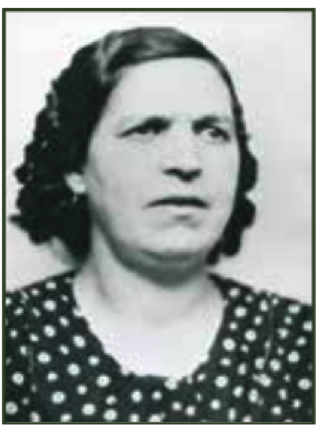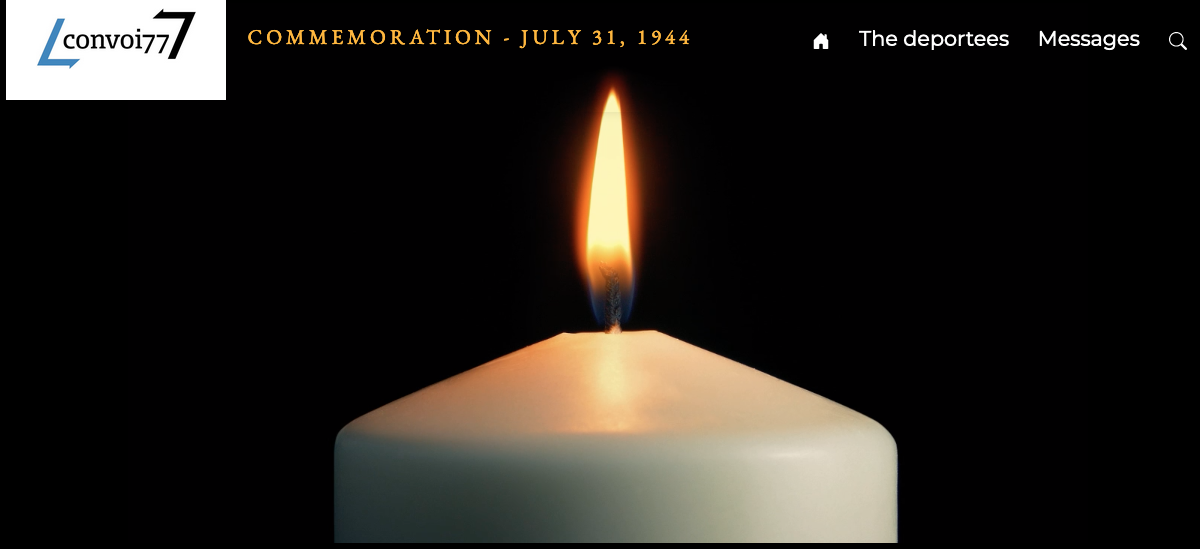Henriette ALLOUCHE
The biography you are about to read was written by Marine Casalini, Valentin Regourd, Katerina Jerabek and Arwen Leroy, a group of 11th grade students at the Val d’Argens high school in Le Muy, in the Var department of France. The project was carried out during the 2023-2024 school year and supervised by Myriam Lequimener, their history and geography teacher.
Photo source: Booklet (in French) edited by Jean Laloum, page 27
Through online research and with the help of Mr. Jean Laloum, we managed to contact Huguette Binesti, the daughter of Henriette Allouche (née Bouskila) and the sister of Cécile Delugin (née Allouche). She then put us in touch with Monique Delugin, her niece, who is Henriette’s granddaughter and Cécile’s daughter. We would like to extend our heartfelt thanks to them for all their help, both in providing us with a wealth of information and in working with the students at our school.
We based our research on records from the Shoah Memorial in Paris, the French Defense Historical Service and the National Resistance Museum in Champigny website.
This is the biography of Henriette Allouche (née Bouskila). Her daughter Cécile Delugin’s biography is also available on the Convoy 77 website.
***************
Ouraïda Henriette Bouskila was born in Constantine, in Algeria, on December 22, 1900. Her parents were Isaac Bouskila, a tailor, and Reina Allouche, a seamstress. We have no information about Henriette’s childhood. We do know, however, that on January 9, 1924 in Constantine, she married one of her cousins, Lucien Khalfallah Allouche, who was born on February 19, 1902, also in Constantine. They went on to have three daughters: Cécile on May 3, 1928, Eliane on May 6, 1934 and Huguette on May 24, 1937.
In late 1937, the family moved to Paris. They initially lived on Rue des Jardins Saint-Paul, and then moved to 25 Rue des Écouffes. Lucien was a painter and decorator and Henriette stayed at home to look after the girls. The family was not unduly worried in the early days of the war. Lucien was called up in 1939 but was demobilized soon after the armistice. When the Germans occupied France, he found work wherever he could. On October 7, 1940, the Vichy government repealed a law known as the Crémieux Decree, which had granted French citizenship to Jews in Algeria. As a result, the family became French “subjects,” which put them on a par with all the other people living who lived in the French colonies. At the same time, the government introduced a series of measures aimed at the Jewish population: they had to take part in a census, for example, their identity papers were stamped and they had to wear the yellow star. French Jewish families such as Henriette’s became caught up in a web of new rules and regulations. The only glimmer of hope for the family came in January 1942, when Gérard, the youngest child, was born.
One day in 1943, two police officers, one French and the other German, knocked at the door of the family home. Huguette was six years old at the time, Éliane was eight, and Cécile, who was older, was at school. The policemen opened a thick ledger, some two feet long, and proceeded to question the family. They asked Henriette to check the names of all the family members. However, since she was unable to read or write, it was her daughter Huguette – the one we met – who read out the names. Both Huguette and Éliane could read quite well, as they were taking evening classes in Le Marais led by a nun, Sister Agnès (who was to be a great help to them later on). At the end, just as they were leaving, the French police officer told Henriette to hide the children, and fast.
The family then decided that they should split up, and would have to conceal their true identities by means of forged identity cards. Henriette et Lucien went to stay with a family in Saint-Cloud, on the western outskirts of Paris. Henriette did the cooking, while Lucien was the gardener and handyman. Little Gérard, who had bandy legs, was taken in by a friend of the family who took had him admitted to the Rothschild Hospital for an operation. He had to stay there for quite some time, with his legs in plaster. It was when she was on her way to visit him in hospital, on July 22, 1944, that his older sister Cécile was arrested just as she was leaving the subway station. Unfortunately, she had a note of her parents’ address with her. The French police went to 8 rue de Garches in Saint Cloud and arrested Henriette, Lucien and also the family they were staying with. Henriette and Lucien were held in the police station for three days. They were then transferred to a building on Rue des Saussaies where the Gestapo interrogated people. The Allouche family only found out later that the people who had had taken in Lucien and Henriette and kept them hidden were shot. On July 26, Lucien was tortured and then thrown out of a window, and died of his injuries. That same day, Henriette was taken to Drancy internment camp, where she met up with her daughter, Cécile. On July 31, 1944, both mother and daughter were deported to Auschwitz on Convoy 77.
There were so many deportees on the train, all crammed in together, and Cécile was so afraid that she clung so hard to her mother that she dug her nails into her shoulder. When at last they got off the train after an arduous three-day journey, they were beaten with truncheons. Henriette, who was deemed unable to work, was taken straight to the gas chambers and murdered. Cécile, however, was selected for forced labor an sent into the camp.
In 1946, the French Ministry of Veterans and Victims of War acknowledged that Henriette had died. A note in her file states that she was a “racial deportee” (meaning that she was deported for political reasons and on grounds of her “race”), and that the circumstances of her death meant that she was deemed to have “Died for France”.
We were honored to have the opportunity to speak with Henriette’s third daughter, who was so very young when her mother died, and to hear from her granddaughter, who knew Henriette only through her mother Cécile’s singular and invaluable stories. We found it all deeply moving. Through this biography, we hope to help preserve the memory of Henriette Ouraïda Allouche, née Bouskila, for generations to come.


 Français
Français Polski
Polski









